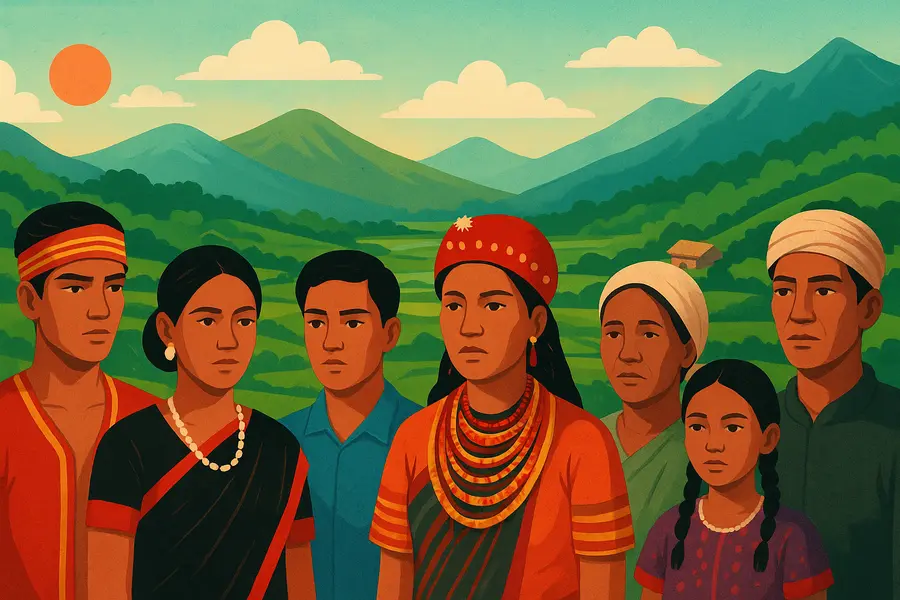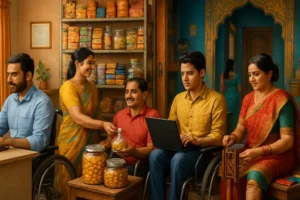Imagine standing at the edge of India, where lush hills meet winding rivers, and hundreds of unique tribes call the Northeast their home. Yet, today, this vibrant region still struggles with a silent barrier: social exclusion.
From being cut off by geography to being misunderstood in mainstream politics and media, Northeast communities often face discrimination, economic neglect, and cultural invisibility. The result? Broken trust, unequal opportunities, and cycles of conflict and displacement.
Let’s explore how social exclusion affects India’s Northeast communities, why it continues even today, and what it means for the future of identity, development and democracy. Because inclusion here is not just policy—it’s survival, dignity, and belonging.

How Does Social Exclusion Affect India’s Northeast Communities in 2025?
The Northeast of India — seven (now eight, counting Sikkim depending on classification) states tucked into a green, mountainous corridor between Bangladesh, Myanmar, Bhutan, China and Nepal — is one of the country’s richest stores of cultural diversity. It is home to hundreds of distinct tribes, languages and customs.
India’s Northeast comprises eight states (Arunachal Pradesh, Assam, Manipur, Meghalaya, Mizoram, Nagaland, Sikkim, and Tripura) and is home to a vast array of communities, including over 200 tribes, each with distinct languages, traditions, and cultural identities.
Key communities include the Bodo, Garo, Khasi, Naga, Mizo, and Adi, whose lives are shaped by the region’s unique terrain, rich biodiversity and historical factors.
For decades many communities there have experienced social exclusion in multiple forms: economic neglect, cultural misunderstanding, political marginalization and, at times, violent conflict.
In this article. We will break down what social exclusion means in the Northeast, why it matters, how it shows up in people’s lives, and what practical steps could help reverse it.
What do we mean by social exclusion?
Social exclusion is when people or groups are systematically blocked from opportunities, rights, resources or voice that others enjoy. It’s not only about poverty — it’s about being kept out of political influence, services, markets, social recognition, or cultural respect. In the Northeast, exclusion often plays out along these lines:
- Territorial and legal exclusions — policies that limit movement, land rights, or citizenship benefits for some groups.
- Economic exclusion — lack of infrastructure, investment, jobs and markets.
- Political exclusion — weak representation, sidelined voices, or governance that doesn’t reflect local realities.
- Cultural exclusion — dominant narratives that erase or stigmatize local languages, customs or identities.
When several of these overlap, exclusion compounds: education gaps make political participation harder; lack of roads blocks markets and healthcare; legal uncertainty about land fuels conflict.
Why the Northeast is particularly vulnerable to exclusion (historical and structural roots)
A few structural facts help explain why social exclusion became entrenched in the region:
- Geography & connectivity: The Northeast is physically separated from mainland India by the Siliguri “chicken neck”. For decades poor road, rail and communications links increased economic isolation and raised transaction costs for trade and services.
- Colonial legacies: British-era administrative divisions, frontier policies and treaty lines often treated hill communities differently from plains communities; those administrative separations hardened into later legal arrangements and political perceptions.
- Post-partition disruptions: The 1947 partition and later migration across borders (e.g., from erstwhile East Pakistan/Bangladesh) reshaped demographics in states like Assam and Tripura, creating competition over land and identity.
- Diverse ethno-linguistic make-up: The region hosts many small, territorially concentrated communities. In such contexts, even small shifts in access or policy can produce large feelings of being sidelined, leading to identity-based mobilization.
- Security-first responses: For decades, the central state often prioritized security responses (counter-insurgency, special laws) over political dialogue and development — a pattern that has sometimes deepened alienation.
These structural dynamics mean exclusion in the Northeast isn’t a single problem — it’s a web of interacting political, economic, legal and cultural forces. Scholarly work examining social exclusion in the region has traced how these multi-dimensional exclusions feed ethnic assertions and unrest.
The different faces of exclusion in everyday life
Let’s make it concrete: how does exclusion feel to people on the ground? Here are common domains where effects show up.
Political & institutional exclusion
Some communities feel under-represented in state structures (police, bureaucracy, local councils). Formal protections like the Sixth Schedule and special permits (Inner Line Permit—ILP) exist for certain tribal areas, but their coverage is patchy and contentious. The Sixth Schedule provides autonomy to some tribal districts, yet debates persist about its reach and effectiveness.
Legal and citizenship anxieties
Questions over who is a “local” vs an “outsider” — amplified by migration, land pressure, and politics — create insecurity. These debates can escalate to demands for citizenship clarification, and sometimes to violent confrontation.
Economic exclusion and infrastructure gaps
Many districts lag on roads, reliable electricity, healthcare facilities, and markets. A lack of connectivity reduces job opportunities and raises costs for businesses. Government programs and targeted funding have improved things in recent years, but uneven progress keeps gaps alive. Recent NITI/NER reports show progress on some SDG indicators but also highlight persistent disparities across districts.
Cultural exclusion and stigmatization
Local languages, dress, folk practices and governance norms are sometimes treated as “other” in national discourse. Media and policy stereotypes can reinforce marginalization, making people feel culturally invisible.
Security and human rights concerns
Extraordinary legal regimes and frequent militarized policing have left many communities feeling treated as security problems rather than citizens with rights. Concerns around human rights violations have been repeatedly raised by national and international watchdogs.
Read Here: The Impact of Educational Gaps on India’s Tribal Communities
Big consequences: displacement, conflict and human costs
When exclusion deepens, the human impacts are severe and multi-layered. Three of the most visible consequences are:
Violent conflict and insurgency
Identity-based exclusion can fuel armed movements that claim to defend “locals” or “indigenous” rights. Insurgencies in parts of the Northeast — historically active in states like Nagaland, Manipur, Assam and Mizoram — have roots in perceived economic, political and cultural exclusion. Security responses can sometimes further alienate communities, creating cycles of violence.
Researchers link social exclusion to both the emergence and persistence of insurgencies in the region. Where governance fails to provide legitimate avenues for grievance redress, people may turn to non-state actors.
Forced displacement and humanitarian crises
Large outbreaks of ethnic violence have caused mass displacement. For example, the ethnic clashes in Manipur since 2023 displaced tens of thousands of people into relief camps under precarious conditions. These displacements exacerbate poverty, break social networks, interrupt education and create long-term trauma. News and humanitarian reporting have documented tens of thousands living in squalid camps with limited prospects for safe return.
Development deficits: health, education, and livelihoods
Exclusion translates into measurable gaps: poor health indicators, school dropouts, low formal employment, and persistent multidimensional poverty in pockets. Even when national indicators improve, many districts in the Northeast continue to lag behind in human development measures, because exclusion limits the reach and effectiveness of public services.
Case study: Manipur — how exclusion can spiral into widespread crisis
The crisis that erupted in Manipur in 2023 is a sharp illustration of how identity politics + exclusion can escalate fast.
A long-standing demand by some Meitei groups for Scheduled Tribe status (which would change access to land and reservations) set off acute tensions with hill tribal communities (Kuki-Zo groups) who feared loss of rights.
Rooted grievances over land, jobs and political power mixed with immediate triggers to produce violent clashes. The aftermath included high fatalities, targeted attacks on civilians, and mass displacement — with tens of thousands in relief camps.
Humanitarian reports documented poor living conditions in camps and deep mistrust between communities.
Why does this matter beyond Manipur? Because it shows how legal ambiguity, resource scarcity, identity claims and weak conflict-management mechanisms can combine rapidly — producing humanitarian crises and long-term exclusion of affected populations.
Laws and policies shaping exclusion — protective, divisive, or ambiguous?
A number of central laws, constitutional arrangements and state policies shape inclusion/exclusion patterns in the Northeast. These policies are often double-edged: they were created to protect local communities, but sometimes they create new tensions.
The Sixth Schedule: Designed to provide autonomy to tribal areas (autonomous districts and regions) in Assam, Meghalaya, Tripura and Mizoram, the Sixth Schedule aims to protect tribal land and customs via district-level councils. It’s a protective measure — but uneven application and changing demographics have created friction in some areas.
Inner Line Permit (ILP): ILP is a colonial-era permit system allowing only certain outsiders to enter and stay in designated areas (e.g., Arunachal Pradesh, Nagaland, Mizoram). It protects local cultures and land rights but is sometimes criticized for limiting movement and economic exchange.
AFSPA — Armed Forces (Special Powers) Act: AFSPA gives sweeping powers to security forces in “disturbed areas.” While intended to maintain order during insurgency, it has been linked with allegations of human rights abuses and a sense among civilians of being under occupation rather than protected. International and national human rights organizations have repeatedly documented human rights concerns under AFSPA, which contributes to a sense of alienation.
Citizenship, migration and local politics: Debates about who counts as a “local” — often tied to recent migration — have been central to exclusionary politics in Assam and beyond. National policies (like the Citizenship Amendment) have fueled anxiety and protest in parts of the Northeast, because many feel such measures can alter demographic balances and undermine existing protections.
Development efforts and progress — the glass is not empty
It’s not all doom: the Indian government and international partners have invested in the region’s development, and there are clear areas of progress.
- Targeted funding & planning: Ministries and agencies (DoNER, NITI Aayog, state governments) have rolled out region-specific schemes, infrastructure drives, and development indices for monitoring. Recent NITI Aayog reports and SDG monitoring for the Northeast show improvements in some key indicators, even if many districts still lag.
- Connectivity projects: Road, rail and digital projects over the last decade have improved market access and mobility in several states — gradually reducing some forms of economic exclusion.
- Local governance & autonomous councils: Where autonomous councils are functioning with local legitimacy, they have helped protect land rights and cultural practices while enabling local decision-making.
- Civil society & cross-community work: Local NGOs, faith-based groups and youth networks have been crucial in building inter-ethnic dialogue, humanitarian response, and livelihood programs.
So, progress exists — but it is uneven. Where governance is weak or conflict is active, gains are fragile and can be reversed.
Who suffers most? The groups that face layered exclusion
Not everyone experiences exclusion equally. Certain groups are particularly vulnerable:
- Women: In conflict and displacement, women face gender-based violence, limited access to reproductive healthcare, and economic marginalization.
- Children and youth: Interruptions to schooling and limited job prospects can trap young people in cycles of instability.
- Small tribal communities: Tiny linguistic or cultural groups may have little political clout and face cultural erasure.
- Internally displaced persons (IDPs): People in camps lose livelihoods and access to services.
- Returnees and migrants: People who move back and forth across borders or states often lack legal security or land rights.
Layered identities (e.g., woman + tribe + displaced) multiply vulnerability.
Pathways to inclusion: What works (and what to avoid)
Building inclusion in Northeast India means empowering local voices, ensuring fair development, and protecting cultural identities—while avoiding one-size-fits-all policies, security-heavy approaches, and token gestures that deepen social exclusion.
Below are evidence-informed approaches that can reduce social exclusion in the Northeast. These are drawn from program experience, academic analysis and policy reports.
Strengthen local governance and meaningful autonomy: Work with (not around) local institutions: empower elected local bodies, strengthen the democratic functioning of autonomous councils, and ensure that local leaders have real budgetary and administrative authority.
Invest in connective infrastructure — thoughtfully: Roads, digital connectivity, and market linkages reduce economic isolation — but infrastructure must be planned with local consent, land safeguards, and environmental care.
Protect rights while reforming security approaches: Replace heavy-handed security-first responses with a mix of law-and-order, accountability, and robust civil liberties. Where AFSPA has been a flashpoint, independent accountability mechanisms and community policing can restore trust.
Fix legal ambiguity around land and citizenship: Transparent, fair processes for land records, tenancy laws, and citizenship documentation reduce chronic anxieties over who owns what and who belongs.
Prioritize social cohesion & dialogue: Investments in inter-communal dialogue, peace education in schools, and local truth-sharing mechanisms can prevent grievances from hardening into violence.
Targeted social protection and inclusion programs: Safety nets for displaced families, targeted scholarships, skill programs for youth, and women’s economic empowerment help bridge immediate gaps.
Recognize and nurture cultural pluralism: Include local languages and knowledge systems in school curricula, media and public campaigns. Cultural recognition reduces stigma and strengthens identity-inclusive citizenship.
Practical recommendations for policymakers, civil society and citizens
For lasting change in Northeast India, policymakers, civil society, and citizens must act together. Practical recommendations focus on governance reforms, inclusive development, rights protection, and community dialogue—bridging divides, reducing conflict, and ensuring every community feels represented and respected.
Here’s a compact list of recommended actions — practical, sequenced, and grounded:
Map exclusion hotspots: Use district-level SDG and human development indices to identify the most excluded districts and target them with tailored investments. (NITI Aayog-style indexation can guide resources.).
Expand legal clarity: State and central governments should audit and clarify status on land rights, tribal protections (Sixth Schedule), and permit systems (ILP), with wide consultation so reforms do not create new losers.
Rebalance security with rights: Where extraordinary laws like AFSPA are active, introduce independent review and strengthen civilian policing and judicial oversight to rebuild trust.
Scale livelihoods with market access: Combine infrastructure projects with local skills and market linkages (e.g., cold chains for horticulture, digital marketplaces for handicrafts).
Protect IDPs and rebuild social fabric: Fast-track humanitarian relief, cash assistance, and community rebuilding efforts to avoid long-term ghettoization of displaced persons. Recent crises (Manipur) show the heavy human price when displacement is prolonged.
Invest in women & youth: Focused programs (education, sexual and reproductive health, vocational training) produce multiplier effects for community resilience.
Support independent monitoring and research: Local universities, research institutes and civil society must be supported to produce evidence and hold governments accountable for inclusion outcomes. Scholarly work has highlighted how identity politics and exclusion intertwine in this region — we need more granular, locally led research to guide policy.
Common missteps to avoid
- Top-down one-size-fits-all projects: The Northeast is not uniform. Policies that ignore local governance norms, cultural practices or environmental fragility will fail.
- Over-reliance on security frames: Treating political grievances only as law-and-order problems fuels resentment.
- Tokenistic cultural gestures: Surface-level cultural recognition without economic and political empowerment will not stop exclusion.
- Ignoring women and youth: These groups are not “add-ons” — they are central to long-term inclusion.
Read Here: Impact of Climate Change on Indian Coastal Communities
Conclusion
The story of Northeast India remains one of resilience amid challenges. Social exclusion continues to shape lives through political underrepresentation, economic neglect, and cultural marginalization.
These patterns fuel conflict, displacement, and deep mistrust, showing that exclusion is not just about lacking resources—it is about denied dignity, voice, and belonging.
Yet, pathways to inclusion are visible: stronger local governance, infrastructure that connects without displacing, respect for cultural diversity, and policies rooted in fairness rather than force.
The future of the region depends on shifting from a security-first mindset to a people-first vision. Inclusion here is not optional—it is essential for peace, stability, and prosperity.
When Northeast communities are seen, heard, and empowered, India as a whole becomes stronger, more united, and truer to its democratic promise.





